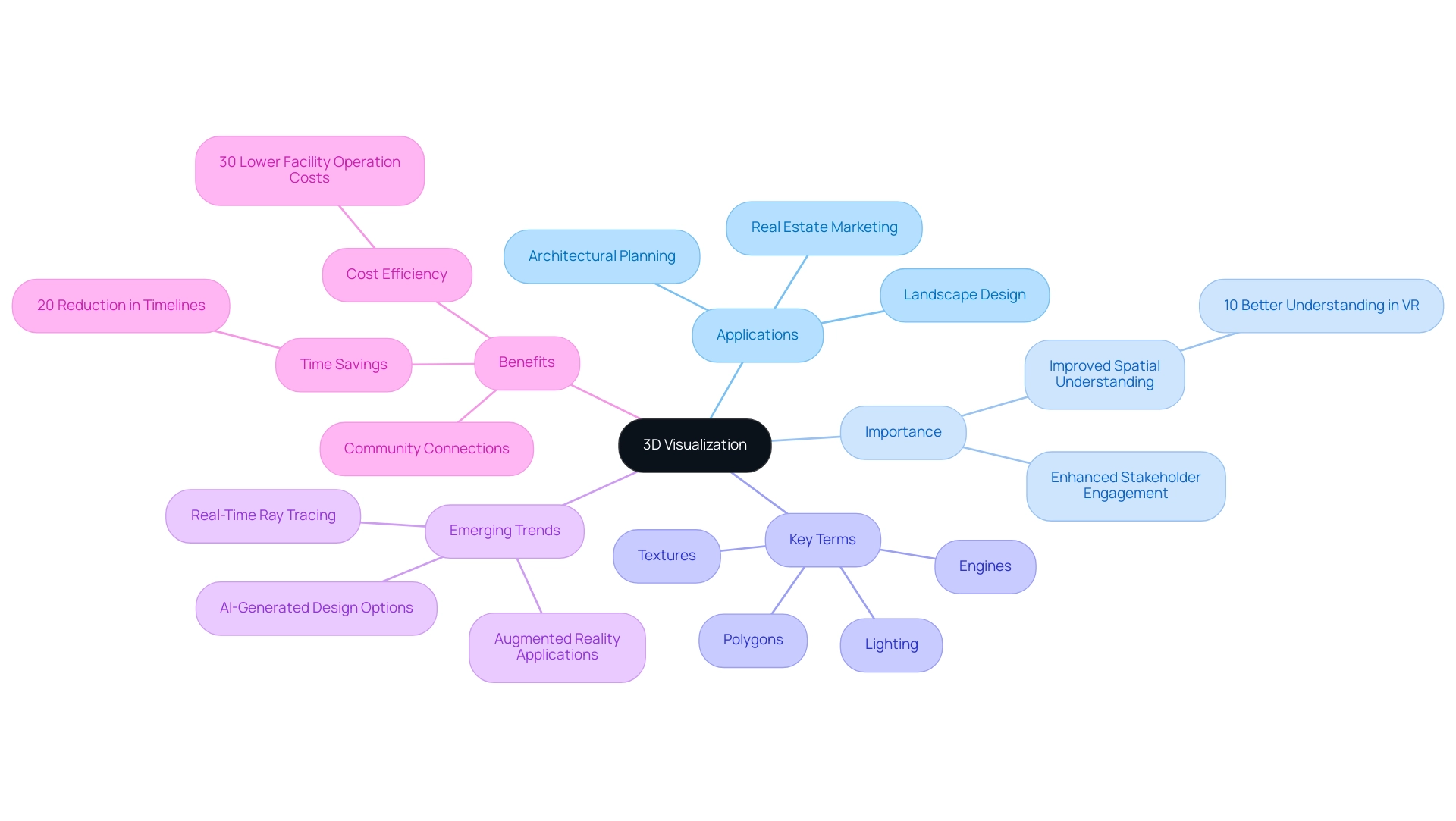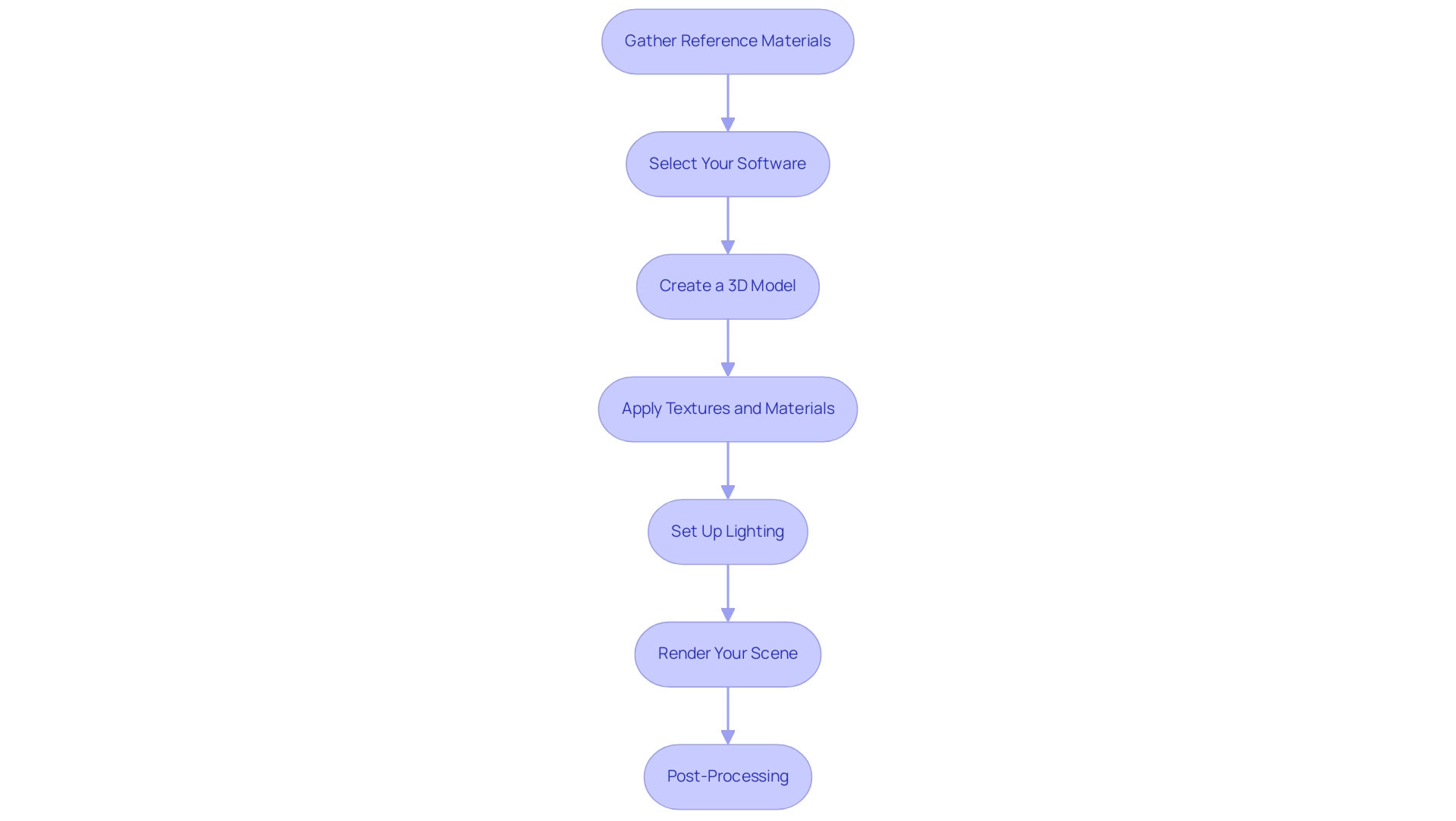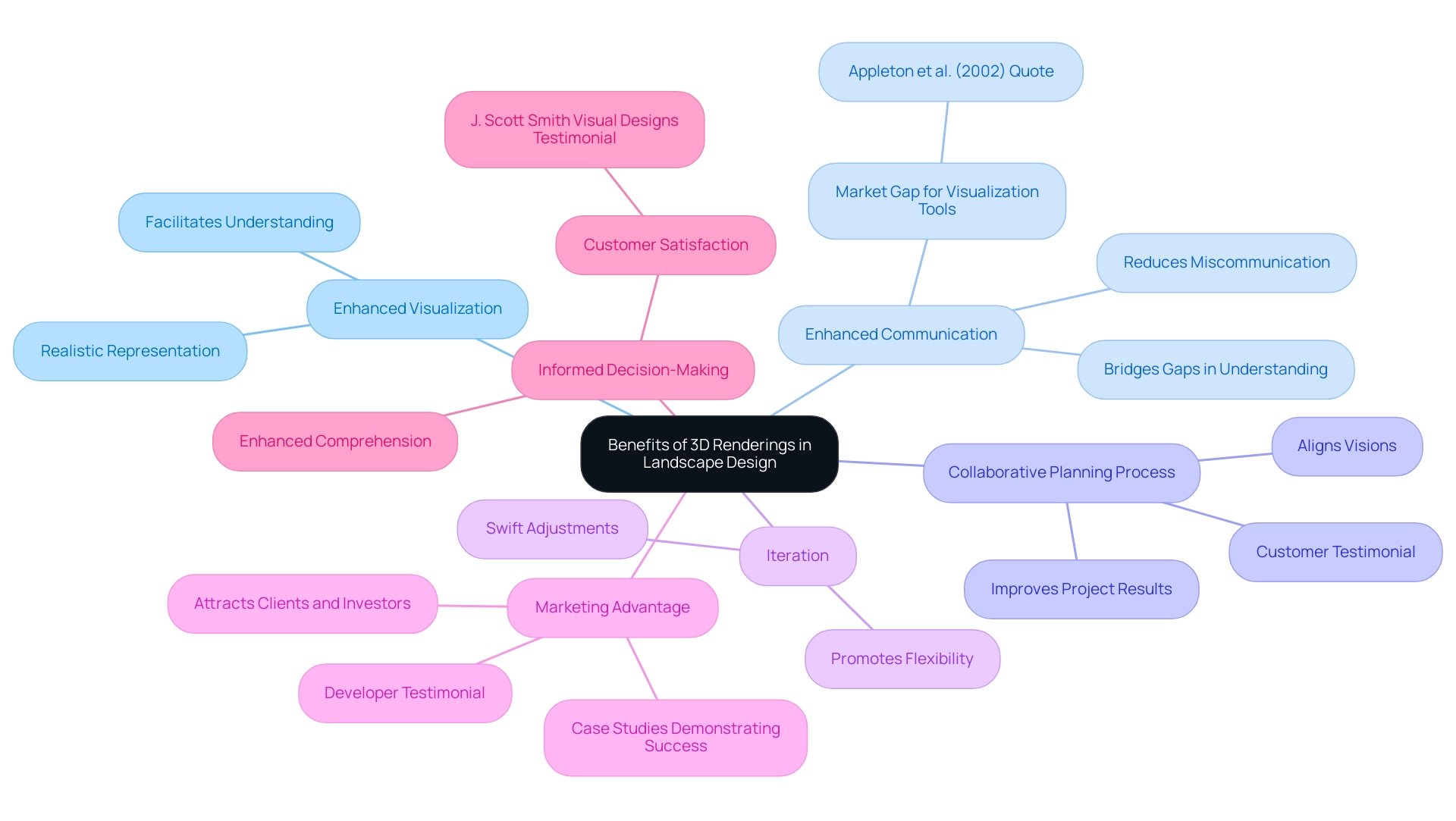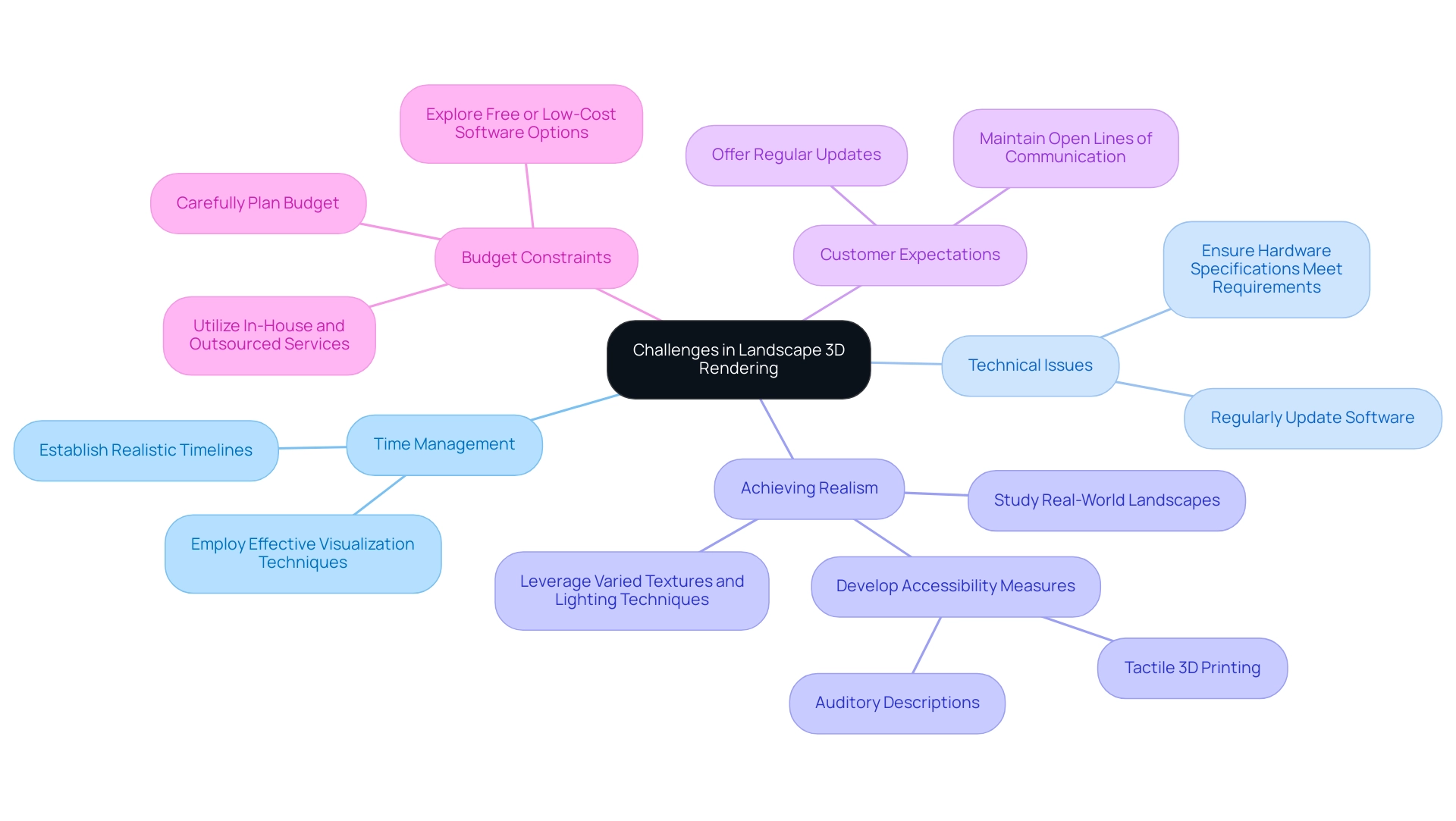Overview
The article provides a comprehensive step-by-step guide on how to effectively showcase landscapes using 3D renderings. It emphasizes the importance of gathering reference materials, selecting appropriate software, and applying techniques such as realistic texturing and lighting to enhance visual appeal, ultimately facilitating better communication and decision-making among stakeholders.
Introduction
In the rapidly evolving field of architectural design, 3D rendering has emerged as an indispensable asset, revolutionizing the way professionals visualize and communicate their ideas. This sophisticated process not only transforms abstract concepts into tangible representations but also enhances client engagement and decision-making.
As architects and landscape designers harness the power of advanced rendering technologies, they unlock the potential for immersive experiences that elevate project presentations and streamline workflows. From the initial modeling phase to the final post-processing touches, understanding the intricacies of 3D rendering is crucial for delivering high-quality visualizations that resonate with stakeholders.
This article delves into the fundamentals of 3D rendering, explores the step-by-step process for creating stunning landscape visuals, and highlights the myriad benefits and tools that are shaping the future of architectural visualization.
Understanding 3D Rendering: Basics and Importance
3D visualization entails the production of a three-dimensional depiction of a physical object or environment using advanced software solutions, acting as an essential resource in architectural planning, especially in the context of townhome visualizations. These illustrations not only highlight the aesthetic appeal of townhomes but also function as a powerful marketing tool in real estate development. In landscape planning, this process empowers architects and creators to accurately visualize the best how to showcase landscapes with 3D renderings, thereby facilitating informed decision-making and effective communication with clients.
The importance of 3D visualization is emphasized by its ability to offer realistic previews, enhancing stakeholder engagement and comprehension. Research from ScienceDirect indicates that participants who explored spaces in VR demonstrated a 10% better spatial understanding than those relying solely on 2D floor plans, underscoring the importance of immersive experiences in architectural design. It is essential for professionals to grasp key terms in the visualization process, including:
- engines
- polygons
- textures
- lighting
as their integration is critical for producing high-quality visuals that reflect both aesthetic intentions and functional requirements.
Furthermore, differing degrees of detail in architectural visuals can considerably influence client involvement; more intricate visuals can promote a greater comprehension and connection to the undertaking. Emerging trends such as AI-generated creation options and real-time ray tracing are transforming the 3D rendering landscape, demonstrating the best how to showcase landscapes with 3D renderings as a pivotal tool in architecture for 2024 and beyond. The widespread adoption of 3D visualization and Building Information Modeling (BIM) has led to significant time savings for architectural endeavors, with firms reporting an average reduction of 20% in timelines.
This efficiency not only diminishes labor costs but also potentially lowers facility operation costs by up to 30% over a building’s lifecycle, showcasing the practical advantages of these advanced technologies. Additionally, the immersive and engaging nature of architectural visualization fosters community connections for future homeowners, making it an indispensable marketing powerhouse in real estate development.

Step-by-Step Process for Creating Stunning 3D Landscape Renderings
Gather Reference Materials: Begin by assembling a comprehensive collection of images, sketches, and plans pertinent to the landscape you aim to render. This foundational material will guide your design process and establish the best way to showcase landscapes with 3D renderings, ensuring accuracy and detail in your final output.
Select Your Software: Choose a visualization software that aligns with your expertise and project specifications. Leading options like SketchUp, Lumion, and V-Ray are widely recognized for their capabilities in architectural visualization and offer robust features suitable for varying complexities. The global market for visualization and 3D imaging software is expanding, driven by urbanization trends and the need for innovative technologies, making it essential to select the right tools for effective client collaboration.
Create a 3D Model: Initiate the modeling phase by accurately crafting the terrain and significant features of the landscape within your chosen software. It is crucial to maintain precise scale and proportions to ensure an authentic representation, capturing the essence of your design. With approximately 126.3 thousand 3D cinema screens worldwide, the relevance of 3D technology in various sectors, including architecture, is substantial.
Apply Textures and Materials: Incorporate high-quality textures for essential surfaces, such as grass, water, and stone, to elevate the realism of your render. The choice of materials plays a pivotal role in the visual appeal and authenticity of the landscape. According to Preeti Wadhwani, ‘the deployment of 3D virtualization and digital marketing trends for products increased product sales by 13%,’ highlighting the effectiveness of 3D visualization in enhancing visual appeal and marketability.
Set Up Lighting: Effective lighting is fundamental to achieving the best way to showcase landscapes with 3D renderings. Experiment with various natural light settings to replicate different times of day, enhancing the depth and atmosphere of your work, which is vital for connecting emotionally with clients.
Render Your Scene: Upon finalizing your setup, proceed to render the scene. Adjust the settings for resolution and quality to meet your desired output standards, ensuring that the details are crisp and clear, which is essential for client satisfaction.
Post-Processing: After creating, utilize image editing software such as Photoshop to refine the final output. This stage permits modifications in colors, contrast, and the inclusion of effects, further enhancing the visual impact of your landscape depiction. By focusing on precision and detail during post-processing, you can achieve the best way to showcase landscapes with 3D renderings, ensuring that your designs resonate with clients and effectively communicate the intended emotional experience.
Collaborate with J. Scott Smith Visual Designs to visualize and confirm your concepts with our initial illustrations. Whether you’re seeking to validate the feasibility of a project or enhance your vision, our conceptual visuals offer the clarity you need to proceed with assurance. Reach out to us today to arrange a consultation and discover how we can help realize your concepts.
The Benefits of 3D Renderings in Landscape Design
The incorporation of 3D visuals in landscape planning provides considerable benefits, making it the best way to showcase landscapes with 3D renderings and improve both the creative process and customer involvement. Among these benefits are:
Enhanced Visualization: High-quality 3D renderings offer clients a vivid and realistic representation of proposed designs, facilitating an immediate understanding of the changes being suggested. This clarity is crucial, particularly in complex projects where visual interpretation is essential for effective decision-making and instilling confidence in stakeholders.
Enhanced Communication: The use of visual aids significantly boosts discussions among architects, customers, and stakeholders, effectively bridging gaps in understanding and reducing the potential for miscommunication. As highlighted by Appleton et al. (2002), there exists a market gap for visualization tools that can synergize with Geographic Information Systems (GIS), underscoring the importance of effective communication in the design process. This gap is particularly significant considering that only 5% of questionnaires were returned electronically, indicating potential barriers in user engagement and feedback mechanisms.
Collaborative Planning Process: The best way to showcase landscapes with 3D renderings is by incorporating detailed interior and exterior renderings, which facilitates a collaborative planning process and aligns visions with expert execution. This method promotes a mutual comprehension between architects and stakeholders, ultimately improving project results. For example, one customer mentioned, “The visualizations assisted us in expressing our vision clearly, resulting in a more seamless collaboration with the creative team.”
Iteration: 3D visualization allows for swift adjustments to concepts, promoting flexibility and fostering creativity during the planning stages. This capability enables architects to explore various design options without the constraints of traditional methods, leading to innovative solutions that meet customer requirements.
Marketing Advantage: Utilizing high-quality visuals in presentations and promotional materials is the best way to showcase landscapes with 3D renderings, effectively highlighting initiatives while attracting potential clients and investors. A visually compelling presentation can significantly enhance a project’s appeal in a competitive market, particularly when implementing the best How to showcase landscapes with 3D renderings, as seen in various case studies demonstrating increased investment interest through effective visual communication. One developer shared, “The renderings we received not only showcased the design beautifully but also sparked investor interest before we even broke ground.”
Informed Decision-Making: With realistic visuals at their disposal, users can utilize the best How to showcase landscapes with 3D renderings to make more informed decisions regarding materials, colors, and layouts. This enhanced comprehension leads to greater satisfaction levels, as individuals feel more engaged and confident in their decisions. Testimonials from customers at J. Scott Smith Visual Designs emphasize how these visual tools have changed their project experiences, with one individual stating, “The clarity of the visuals made it easy to finalize our choices, leading to a result that exceeded our expectations.”
Furthermore, the case study titled “In Search of Visualization Challenges” illustrates the development and implementation of visualization tools aimed at supporting dialogue in urban planning processes. The findings underscore the importance of effective visualization tools in facilitating communication and engagement among stakeholders, aligning with the benefits discussed.
As the industry advances, the benefits of understanding the best how to showcase landscapes with 3D renderings are anticipated to increase, especially as developments persist in improving visualization technology. These tools not only improve communication but also drive client satisfaction, proving to be indispensable in contemporary architectural practices.
Tools and Technologies for Effective 3D Rendering
Effective 3D visualization in landscape planning relies on a set of crucial tools and technologies that improve both quality and efficiency:
Visualization Software: Leading applications such as SketchUp, Blender, and 3ds Max remain pivotal in the modeling and visualization field. Each software provides customized features that meet diverse task requirements, ensuring adaptability in design execution while permitting adjustments and modifications crucial for distinctive visualization tasks.
Rendering Engines: Well-known visualization engines such as V-Ray, Corona Renderer, and Lumion greatly enhance the quality and speed of visualization processes. These engines utilize advanced algorithms to provide the best how to showcase landscapes with 3D renderings, which are vital for impactful visual presentations, enhancing the emotional effect and realism of architectural designs.
Hardware Requirements: To efficiently manage complex processing tasks, high-performance computers equipped with robust GPUs are essential. Investing in high-quality hardware is the best way to showcase landscapes with 3D renderings, as it enhances processing speeds and reduces lag, which is essential for large-scale endeavors and considerably affects resource requirements.
Plugins and Extensions: Enhancing software capabilities with plugins like Enscape for real-time visualization and Artlantis for quick image generation can simplify workflows and improve output quality. These tools enable swift modifications, permitting designers to see changes immediately, thereby improving the buyer experience by utilizing the best how to showcase landscapes with 3D renderings during immersive property exploration.
Cloud Visualization Services: For large-scale endeavors, utilizing cloud visualization services is an effective approach to offload processing tasks. This not only conserves local resources but also accelerates timelines, making it a practical solution for busy architectural firms, ultimately improving business efficiency.
When hiring 3D architectural rendering services, consider looking for providers who exemplify the best how to showcase landscapes with 3D renderings, emphasizing their attention to detail and emotional storytelling through visuals. Don’t hesitate to ask for client testimonials or case studies that demonstrate their ability to meet specific project needs.
In the evolving landscape of digital design, the concept of ‘Digital Twins’ is increasingly relevant.
As pointed out by Paul Hanaphy, Editor, this term signifies the incorporation of advanced technologies in visualization processes, enhancing accuracy and efficiency.
D5 Render is considered one of the best tools on how to showcase landscapes with 3D renderings, gaining popularity for its real-time cloud processing and AI-powered denoising features. This software is selected by architects, landscape designers, and interior designers for its impressive visualizations and intuitive interface, showcasing the abilities of contemporary visualization tools to satisfy the requirements of today’s architectural tasks while greatly improving property value through visual attractiveness and market distinction.
When contemplating outsourcing 3D architectural visualization services, evaluate the possible advantages against the challenges. Outsourcing can significantly enhance efficiency and results, but it is essential to maintain clear communication and set expectations to ensure that the final product aligns with your vision.
Overcoming Challenges in Landscape 3D Rendering
In the realm of landscape 3D rendering, professionals often encounter several challenges that require strategic management to ensure project success:
Time Management: Rendering can be an immensely time-consuming process. To navigate this, it is crucial to establish realistic timelines and employ effective visualization techniques. Utilizing software that provides faster processing options can significantly enhance productivity, allowing for more time to focus on design iterations and client feedback.
Technical Issues: Frequent software crashes or hardware limitations can disrupt workflow. To mitigate these setbacks, make it a practice to regularly update your software and ensure that your hardware specifications align with the requirements of advanced processing applications.
Achieving Realism: The pursuit of realism in 3D environments can be daunting. This challenge can be addressed by studying real-world landscapes and leveraging a mix of varied textures and sophisticated lighting techniques as the best way to showcase landscapes with 3D renderings, which enhances the authenticity of your visualizations. The significance of intricate details—like the way sunlight dances off windows or the texture of bricks—can greatly enhance the emotional impact and realism of visual representations. Additionally, the case study titled “Accessibility for All” highlights that the visual nature of 3D visualizations can exclude individuals with visual impairments, emphasizing the need for accessibility measures. Developing techniques like tactile 3D printing and auditory descriptions can help democratize access and make 3D visualizations more inclusive.
Customer Expectations: Misaligned customer expectations can lead to significant dissatisfaction. To effectively manage these expectations, maintain open lines of communication throughout the rendering process. Interacting with customers and offering regular updates can help ensure that their vision aligns with the project outcomes. Employing 3D visualizations not only nurtures these connections but also serves as one of the best ways to showcase landscapes with 3D renderings, converting architectural visions into clear visuals and facilitating quicker buy-in from stakeholders and investors.
Budget Constraints: The expense of producing can escalate quickly. It is essential to carefully plan your budget and explore free or low-cost software options that can still yield high-quality results. Notably, 8.8% of respondents use a combination of in-house and outsourced services, which can be a strategic approach to managing costs. As David Birkes aptly noted,
Engaging with the community means more than just finding tools;
utilizing resources such as forums and asset libraries can provide valuable support and collaboration opportunities to navigate these challenges.
Addressing these common challenges with well-defined strategies not only enhances the efficiency of rendering projects but also contributes to delivering high-quality results that meet client expectations while streamlining project workflows.
Conclusion
The exploration of 3D rendering in architectural design underscores its critical role in transforming conceptual ideas into engaging visual narratives. By delving into the fundamental aspects of 3D rendering, the article highlights how this technology not only enhances visualization but also significantly improves communication and collaboration among architects, clients, and stakeholders. The step-by-step process for creating 3D landscape renderings illustrates the meticulous attention required at each phase, from gathering reference materials to post-processing, ensuring that the final output resonates with the intended vision.
Moreover, the benefits of integrating 3D renderings into landscape design are manifold. Enhanced visualization fosters informed decision-making, while improved communication bridges gaps in understanding. The collaborative planning process facilitated by detailed renderings allows for greater alignment between client expectations and design execution. As emerging technologies continue to evolve, tools such as advanced rendering software and cloud services further bolster the efficiency and quality of the rendering process, affirming their value in contemporary architectural practices.
In conclusion, 3D rendering is not merely a technical endeavor but a vital asset that empowers architects to present their designs with clarity and impact. As the industry progresses, the importance of mastering these rendering techniques and utilizing the latest technologies cannot be overstated. Embracing these innovations will not only enhance project outcomes but also contribute to a more immersive and satisfying experience for clients, ultimately redefining the standards of architectural visualization in the years to come.





0 Comments